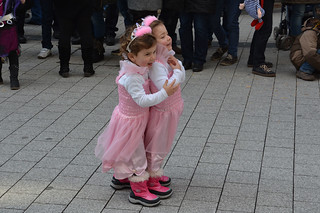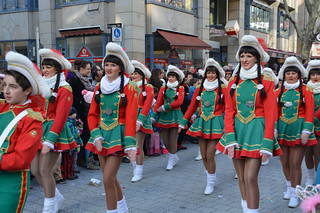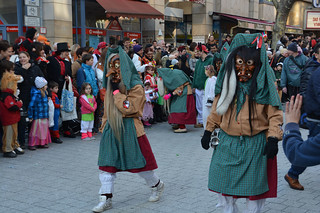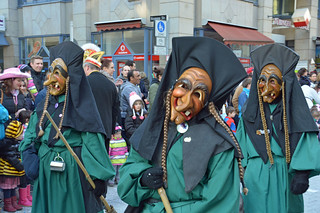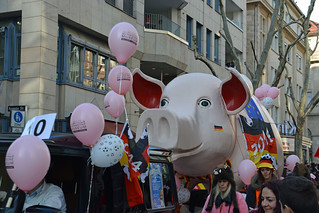The Stoffmarkt Holland fabric market only comes to my town once a year and last year I was out of the country when it came. But this year I marked it on my calendar and clicked the Yes I will attend button on the Facebook event page. I prepared by checking out the yardage needed for a couple patterns and snipping a piece of fabric for which I needed matching serger thread.
The day had perfect weather - high clouds with occasional sunshine. I didn't need a jacket and instead of a purse to get in the way and tug on my shoulder, I wore a small backpack to carry my wallet, phone and purchases. A couple years ago I brought a portable shopping cart with me but that just gave me an excuse to fill it (which I did). My fabric stash is greater than my sewing output so the backpack was a better choice.
This market is crowded! They always schedule this to coincide with the Easter market and an auto expo also going on downtown, so occasional or non-sewers check it out and husbands accompany wives to hold their bags. Yes, I did see a few men handle and purchase fabric but it was primarily women. Older women, younger women, women with children in tow, women speaking all languages. I had difficulty in one notions booth when the clerk couldn't speak English and I didn't know what she was asking me to do and the woman next to me asked Polskie (Polish)? She would have helped me if she could.
I didn't have too much trouble at most booths with my limited German - it's not to hard to just ask for zwei meter - but I was frustrated by one notions booth. They had long tables with a hodgepodge of notions: zippers, thread, buttons, buckles, pins - everything. Just a yard or so in front of the table were those tall spinning racks with more notions hanging on the hooks. So the aisle made between the racks and the table was narrow and thus congested with people looking at the notions and people trying to pass by. And it's always super crowded. They have quite a few clerks, though it's hard to tell who works there and who's a customer. But as soon as you pick something up someone thrusts a plastic basket in your direction. So I took the basket, put my items in it and started to move down a bit to look at some more notions but the clerk started barking at me in German like I was doing something wrong and motioning for me to give her the basket. I understood a few words and think she wanted me to pay for what I had in there first, but I wasn't done shopping. I still don't understand what they wanted me to do - I guess put a few things in the basket and buy them and then get another basket a few feet down? I don't know. Frustrated and feeling claustrophobic by the crowd, I gave up and left my basket of things with her. Later I came back and bought the interfacing and thread that I wanted to purchase the first time and didn't bother buying anything else there.
My other problem with shopping was indecision. So many possibilities. So many fabrics I could envision making into things. Prices are pretty good too. Most of what I was attracted to was in the 8-14 Euro/meter range. Not a super bargain but perhaps a little cheaper than in the local stores, however the selection is what is appealing. There were a few booths with expensive fabric (24-35 Euros/meter) but it wasn't fancy-expensive fabric like beaded or embroidered, it was just really nice linen, wool or silk. One vendor in particular, TST-Stoffen, has been at previous markets I've been and the fabrics are really something special - Knipmode uses them often. I'm always tempted and this year I was prepared to buy a meter or two until I realized that their prices are no better than they have in their online store.
 |
| Picture taken to capture the name of the store and price, not for the fabric, though it's lovely. |
Here's what I eventually bought:
From left to right:
- Black with pink polka dots. Cotton with a small bit of elastane
- Pink, beige, black, white knit with a quilted texture. Cotton and viscose I think.
- Pink and white butterfly print. Viscose
- Interfacing
- 5 pieces of vinyl coated cotton - for bags or zipper pouches
- Cotton knits in a blue/beige (it's beige on the other side) and solid beige
- Serger thread - I buy one cone to match color and wind onto empty spools to make more "cones"
- Bear print cotton - it's a heavier weight with one big bear on it. I plan to make either a book bag or a pillow out of it

Isn't he cute? - Pink and black variegated knit. Cotton and maybe viscose. Don't remember.
- Black, white, gray voile large scale print. Cotton and silk according to the vendor. I found this on a bargain table - 10 Euros for the 2 meter cut of fabric.
So there you go. Fabric market!

















.jpg)





.png)






